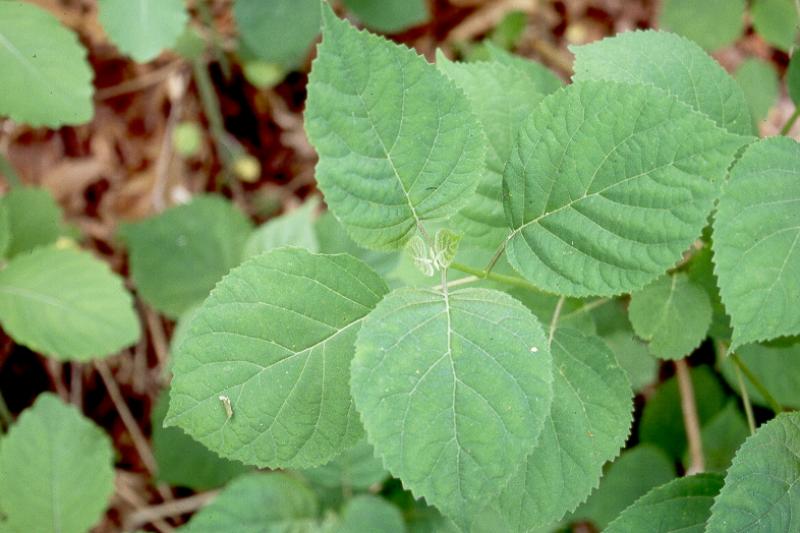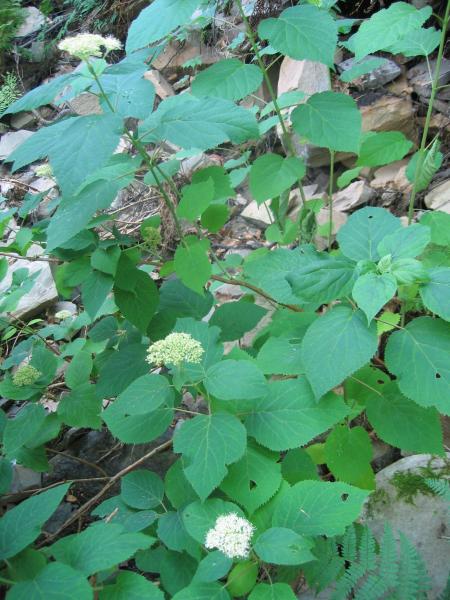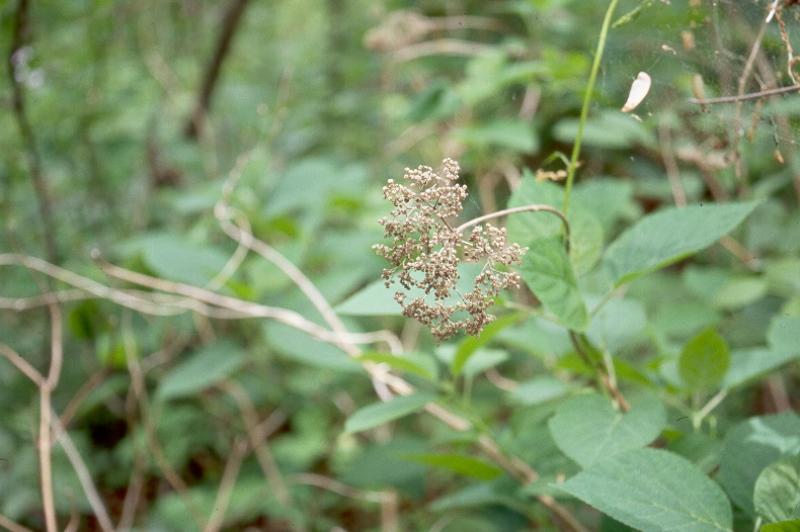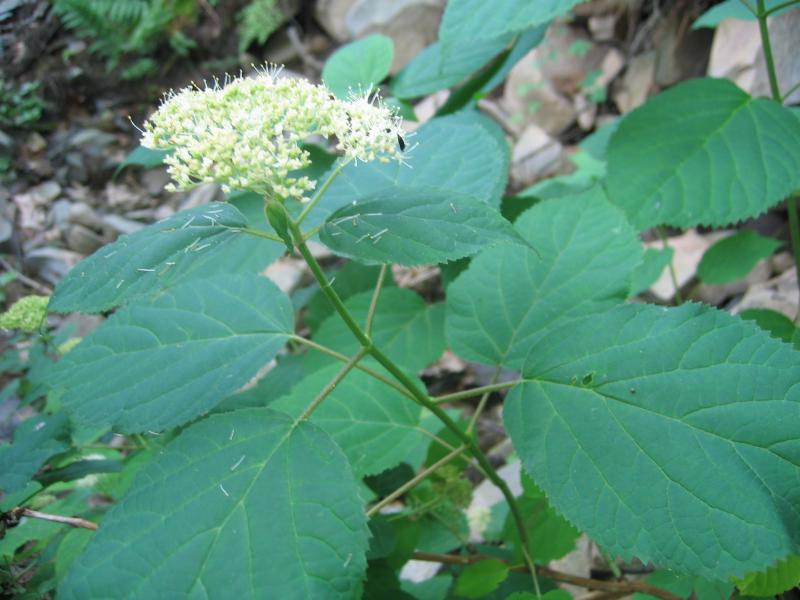Wild Hydrangea
Hydrangea arborescens L.
- Class
- Dicotyledoneae (Dicots)
- Family
- Hydrangeaceae (Hydrangea Family)
- State Protection
- Threatened
Listed as Threatened by New York State: likely to become Endangered in the foreseeable future. For animals, taking, importation, transportation, or possession is prohibited, except under license or permit. For plants, removal or damage without the consent of the landowner is prohibited.
- Federal Protection
- Not Listed
- State Conservation Status Rank
- S2
Imperiled in New York - Very vulnerable to disappearing from New York due to rarity or other factors; typically 6 to 20 populations or locations in New York, very few individuals, very restricted range, few remaining acres (or miles of stream), and/or steep declines.
- Global Conservation Status Rank
- G5
Secure globally - Common in the world; widespread and abundant (but may be rare in some parts of its range).
Summary
Did you know?
Wild Hydrangea is widely available in the horticulture trade, especially for shade gardens. The two most popular varieties are 'Annabelle' and 'Grandiflora'. Its roots have been used for hundreds of years in folk and Native American medicine for the treatment of various ailments, especially for the prostate gland. The common name "seven-bark" refers to the way the bark peels off in several layers of various colors.
State Ranking Justification
There are ten existing populations but most of these are in ravines and on steep slopes that are not likely to be affected by development or logging. Most of the populations are rather limited in size. There are 10 historical records but eight have not been searched.
Short-term Trends
Too few of our populations have been surveyed more than once, so trend information is too difficult to assess. Considering this shrub is mostly restricted to headwater stream areas and these have received some recent protection, one could speculate these popualtions are stable.
Long-term Trends
As a shrub of ravine systems, these have been afforded limited protection. Some have likely been lost over time as roads followed some of these corridors. However, New York is at the northern range limit and this is one of those plants that has likely always been rare. The historical populations within the Hudson Valley appear to have been destroyed.
Conservation and Management
Threats
Some populations are near roadsides, so improper road maintenance could impact these populations. Garlic mustard was evident in large numbers at one population which may affect recruitment but established shrubs were not affected.
Conservation Strategies and Management Practices
Plants along the roadside should be protected from improper road maintenance and excessive salt. Invasive plants should be eliminated in the area. Logging of surrounding woodlands should be aware of this rare shrub and use best management practices to reduce direct impact/damage to the plants as well as indirect harm resulting from excessive light levels and the introduction of invasives.
Research Needs
For this plant as well as others, research is needed to determine the effects of seedling recruitment in areas with a high garlic mustard population.
Habitat
Habitat
This shrub is typically found on the slopes of forested ravines along the Southern Tier adjacent to the Pennsylvania border. It is often found in the upper headwater ravine systems where it may be close to the stream, along the ravine slopes, or occasionally on ledges. The moist soil may be rocky and/or have a high clay content (New York Natural Heritage Program 2006). Rich woods, slopes, and streambanks (Rhoads and Block 2000). Dry or moist, often rocky woods and hillsides (Gleason & Cronquist 1991). Rich woods, calcareous rocky slopes, banks of streams, etc. (Fernald 1970).
Associated Ecological Communities
- Appalachian oak-pine forest*
(guide)
A mixed forest that occurs on sandy soils, sandy ravines in pine barrens, or on slopes with rocky soils that are well-drained. The canopy is dominated by a mixture of oaks and pines.
- Cliff community*
(guide)
A community that occurs on vertical exposures of resistant, non-calcareous bedrock (such as quartzite, sandstone, or schist) or consolidated material; these cliffs often include ledges and small areas of talus.
- Hemlock-northern hardwood forest
(guide)
A mixed forest that typically occurs on middle to lower slopes of ravines, on cool, mid-elevation slopes, and on moist, well-drained sites at the margins of swamps. Eastern hemlock is present and is often the most abundant tree in the forest.
- Limestone woodland
(guide)
A woodland that occurs on shallow soils over limestone bedrock in non-alvar settings, and usually includes numerous rock outcrops. There are usually several codominant trees, although one species may become dominant in any one stand.
- Maple-basswood rich mesic forest*
(guide)
A species rich hardwood forest that typically occurs on well-drained, moist soils of circumneutral pH. Rich herbs are predominant in the ground layer and are usually correlated with calcareous bedrock, although bedrock does not have to be exposed. The dominant trees are sugar maple, basswood, and white ash.
- Rich mesophytic forest*
(guide)
A hardwood or mixed forest that resembles the mixed mesophytic forests of the Allegheny Plateau south of New York but is less diverse. It occurs on rich, fine-textured, well-drained soils that are favorable for the dominance of a wide variety of tree species. A canopy with a relatively large number of codominant trees characterizes this forest. Canopy codominants include five or more of the following species: red oak, red maple, white ash, American beech, sugar maple, black cherry, cucumber tree, and black birch.
- Rocky headwater stream
(guide)
The aquatic community of a small- to moderate-sized perennial rocky stream typically with a moderate to steep gradient, and cold water that flows over eroded bedrock, boulders, or cobbles in the area where a stream system originates.
* probable association but not confirmed.
Associated Species
- Acer pensylvanicum (striped maple)
- Acer rubrum var. rubrum (common red maple)
- Acer saccharum (sugar maple)
- Acer spicatum (mountain maple)
- Adiantum pedatum (maidenhair fern)
- Amphicarpaea bracteata (hog peanut)
- Anemone virginiana var. virginiana
- Aralia nudicaulis (wild sarsaparilla)
- Asarum canadense (wild ginger)
- Athyrium filix-femina ssp. angustum
- Betula alleghaniensis (yellow birch)
- Betula lenta (black birch)
- Caulophyllum thalictroides (blue cohosh, late blue cohosh)
- Clematis virginiana (virgin's-bower)
- Cornus rugosa (round-leaved dogwood)
- Desmodium glutinosum
- Diervilla lonicera (bush-honeysuckle)
- Dryopteris intermedia (evergreen wood fern, fancy wood fern, common wood fern)
- Dryopteris marginalis (marginal wood fern)
- Eurybia divaricata (white wood-aster)
- Eurybia schreberi (Schreber's-aster)
- Fraxinus americana (white ash)
- Gymnocarpium dryopteris (oak fern)
- Hamamelis virginiana (witch-hazel)
- Hesperis matronalis (dame's rocket)
- Lonicera morrowii (Morrow's honeysuckle)
- Mitella diphylla (two-leaved mitrewort, two-leaved bishop's-cap)
- Osmunda claytoniana (interrupted fern)
- Pinus strobus (white pine)
- Polystichum acrostichoides (Christmas fern)
- Prunus virginiana
- Quercus alba (white oak)
- Quercus montana (chestnut oak)
- Quercus rubra (northern red oak)
- Rubus allegheniensis (common blackberry)
- Rubus idaeus
- Rubus occidentalis (black raspberry)
- Rubus odoratus (purple-flowering raspberry)
- Sambucus racemosa var. racemosa
- Sassafras albidum (sassafras)
- Solidago caesia
- Solidago rugosa
- Thalictrum dioicum (early meadow-rue)
- Tilia americana var. americana (American basswood)
- Tsuga canadensis (eastern hemlock)
- Ulmus americana (American elm)
- Viburnum acerifolium (maple-leaved viburnum)
Range
New York State Distribution
Most populations within New York are from the Southern Tier adjacent to the Pennsylvania border. Those specimens from the southern Hudson Valley are old collections that appear to be from native landscapes. No native populations are today known from the Hudson Valley.
Global Distribution
The native range of this shrub stretches from southern New York to Ohio, Indiana, Illinois, Missouri, and Oklahoma, south to Louisiana and Florida. This has been introduced to Massachusetts, New Brunswick, Nova Scotia, Ontario, and probably elsewhere.
Identification Comments
General Description
Wild hydrangea is a deciduous open shrub that grows 5-6 feet tall. The bark is brown and peels in numerous layers. The opposite leaves are 3-6 inches long, broadly oval or heart-shaped, and sharply toothed. They are dull, dark green above and slightly paler beneath. The showy flower cluster is flat-topped and up to 4 inches wide. It contains many greenish-white or white fertile flowers and sometimes a few sterile flowers around the edge that have large white showy sepals. The small brown dry fruits form in the late summer and are visible into the early winter.
Identifying Characteristics
This shrub of stream banks, rocky slopes, and ravine systems may grow to 3 meters tall, although most of our plants are 1-2 meters tall. The long-petioled leaves are ovate-oblong, with an acuminate point and serrate teething along the margins, and can reach a length up to 20 cm. The flowering head is 5-10 cm wide with a corymb flat- or convex- top. For the true native strain, nearly all the flowers are perfect or with just a few sterile flowers. The sterile flowers are more radiant looking as they produce a large 3 or 4 lobed calyx. The perfect flowers will have flowers with 5 petals, these are much smaller than the showy calyx bracts of the sterile flowers.
Best Life Stage for Proper Identification
Plants should be collected in flower or fruit to verify identification and avoid confusion with various common cultivars. Collected specimens should include a portion of the stem with leaves and flowers/fruits to allow for positive verification.
Similar Species
Hydrangea paniculata is a rare escapee that has flowers in elongated panicles. There are also various cultivars of Hydrangea arborescens. Most of these have flowering heads that are more snowball-like as opposed to the smaller flowering heads and aborted flowers of the true native.
Best Time to See
This shrub begins to leaf out in mid to late May. The flowers emerge late June to early July with fruits appearing by August. Old flowering/fruit heads may perist into the winter, or in a few rare cases for a few seasons. Since flowers or fruits are needed for proper identification, field surveys should wait until late June and may continue through the fall. Flowering plants tend to stick out more, so the ideal survey period in late June to early July.
- Vegetative
- Flowering
- Fruiting
The time of year you would expect to find Wild Hydrangea vegetative, flowering, and fruiting in New York.
Wild Hydrangea Images
Taxonomy
Wild Hydrangea
Hydrangea arborescens L.
- Kingdom Plantae
- Phylum Anthophyta
- Class Dicotyledoneae
(Dicots)
- Order Rosales
- Family Hydrangeaceae (Hydrangea Family)
- Order Rosales
- Class Dicotyledoneae
(Dicots)
- Phylum Anthophyta
Additional Common Names
- Arborescent Hydrangea
- Mountain Hydrangea
- Seven-bark
- Smooth Hydrangea
Synonyms
- Hydrangea arborescens var. oblonga Torr. & A. Gray
Additional Resources
Best Identification Reference
Gleason, Henry A. and A. Cronquist. 1991. Manual of Vascular Plants of Northeastern United States and Adjacent Canada. The New York Botanical Garden, Bronx, New York. 910 pp.
Other References
Fernald, M.L. 1950. Gray's manual of botany. 8th edition. D. Van Nostrand, New York. 1632 pp.
Holmgren, Noel. 1998. The Illustrated Companion to Gleason and Cronquist's Manual. Illustrations of the Vascular Plants of Northeastern United States and Adjacent Canada. The New York Botanical Garden, Bronx, New York.
Mitchell, Richard S. and Gordon C. Tucker. 1997. Revised Checklist of New York State Plants. Contributions to a Flora of New York State. Checklist IV. Bulletin No. 490. New York State Museum. Albany, NY. 400 pp.
New York Natural Heritage Program. 2010. Biotics database. New York Natural Heritage Program. New York State Department of Environmental Conservation. Albany, NY.
New York Natural Heritage Program. 2024. New York Natural Heritage Program Databases. Albany, NY.
Newcomb, Lawrence. 1977. Newcomb's Wildflower Guide: An Ingenious New Key System for Quick, Positive Field Identification of the Wildflowers, Flowering Shrubs, and Vines of Northeastern and North-Central North America. Little, Brown and Company. Boston.
Rhoads, Ann F. and Timothy A. Block. 2000. The Plants of Pennsylvania, an Illustrated Manual. University of Pennsylvania Press, Philadelphia, PA.
Weldy, T. and D. Werier. 2010. New York flora atlas. [S.M. Landry, K.N. Campbell, and L.D. Mabe (original application development), Florida Center for Community Design and Research http://www.fccdr.usf.edu/. University of South Florida http://www.usf.edu/]. New York Flora Association http://newyork.plantatlas.usf.edu/, Albany, New York
Weldy, Troy W. and David Werier. 2005. New York Flora Atlas. [S.M. Landry, K.N. Campbell, and L.D. Mabe (original application development), Florida Center for Community Design and Research. University of South Florida]. New York Flora Association, Albany, NY. Available on the web at (http://newyork.plantatlas.usf.edu/).
Links
About This Guide
Information for this guide was last updated on: January 26, 2009
Please cite this page as:
New York Natural Heritage Program. 2024.
Online Conservation Guide for
Hydrangea arborescens.
Available from: https://guides.nynhp.org/wild-hydrangea/.
Accessed July 26, 2024.



